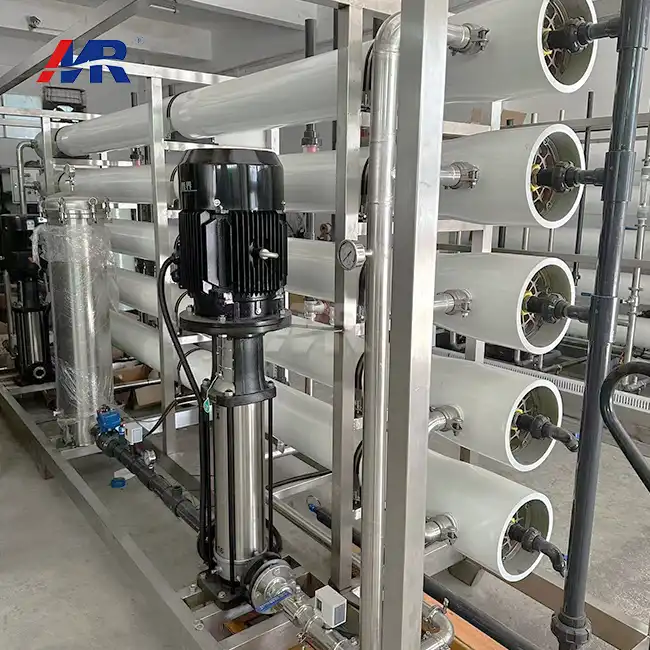Essential pre-treatment stages for reverse osmosis plants
The pre-treatment process in a reverse osmosis plant typically involves multiple stages, each designed to target specific contaminants and protect the RO membranes. These stages work in synergy to provide comprehensive protection and optimize the overall system performance.
Primary filtration: Removing larger particles
The first line of defense in pre-treatment is often a series of progressively finer screens or filters. These components are responsible for eliminating larger particulates, debris, and suspended solids from the feed water. By removing these coarser materials, primary filtration helps prevent clogging and reduces the burden on subsequent filtration stages.
Chemical pre-treatment: Addressing water chemistry
Depending on the feed water composition, chemical pre-treatment may be necessary to adjust pH levels, remove hardness, or address specific contaminants. This stage often involves the addition of antiscalants, which prevent the formation of mineral scale on the RO membranes. Other chemicals may be used to oxidize iron and manganese or to neutralize chlorine, which can damage certain types of RO membranes.
Microfiltration or ultrafiltration: Fine particle removal
For applications requiring exceptionally high water purity, such as in the pharmaceutical or semiconductor industries, additional filtration steps may be incorporated. Microfiltration (MF) or ultrafiltration (UF) systems can be used to remove even smaller particles, colloids, and some microorganisms, further protecting the RO membranes and improving overall water quality.
How sediment filters protect RO system membranes
Sediment filters play a pivotal role in safeguarding the integrity and performance of reverse osmosis system membranes. These filters are specifically designed to capture and retain particulate matter, ranging from sand and silt to rust particles and other suspended solids.
The mechanics of sediment filtration
Sediment filters typically employ a depth filtration mechanism, where particles are trapped throughout the filter media's thickness. As water passes through the filter, progressively smaller particles are captured, with the finest filtration occurring near the core of the filter cartridge. This graduated filtration process ensures efficient removal of a wide range of particle sizes, protecting the RO membranes from potential abrasion and fouling.
Importance of proper sizing and maintenance
Selecting the appropriate sediment filter for your BWRO plant is crucial for optimal performance. Factors such as particle size distribution, flow rate, and contaminant load must be considered when choosing a filter. Regular maintenance and timely replacement of sediment filters are essential to prevent breakthrough of particles and ensure consistent protection of the RO membranes. Neglecting this aspect can lead to premature membrane fouling, reduced system efficiency, and increased operational costs.
Advanced sediment filtration technologies
Innovations in sediment filtration technology have led to the development of more efficient and longer-lasting filter media. Pleated filters, for instance, offer increased surface area and dirt-holding capacity, resulting in extended filter life and improved performance. Some modern sediment filters also incorporate antimicrobial properties to inhibit bacterial growth within the filter media, further enhancing water quality and system hygiene.
The role of carbon filters in BWRO plant maintenance
Carbon filters are an indispensable component in the pre-treatment stage of brackish water reverse osmosis (BWRO) plants. These filters play a crucial role in removing organic compounds, chlorine, and other chemical contaminants that can adversely affect the RO membranes and the quality of the produced water.
Adsorption capabilities of activated carbon
Activated carbon is a highly porous material with an enormous surface area, making it exceptionally effective at adsorbing a wide range of organic compounds and chlorine. In a BWRO plant, carbon filters help remove: - Dissolved organic compounds that can contribute to membrane fouling - Chlorine and chloramines, which can damage thin-film composite (TFC) membranes - Taste and odor-causing compounds, improving the organoleptic properties of the final product water - Trace amounts of pesticides, herbicides, and other synthetic organic chemicals
Types of carbon filters used in RO pre-treatment
Two main types of carbon filters are commonly used in RO pre-treatment: 1. Granular Activated Carbon (GAC) filters: These contain loose carbon granules and are effective for treating large volumes of water. GAC filters offer the advantage of being refillable, potentially reducing long-term costs. 2. Carbon block filters: These filters consist of compressed carbon particles formed into a solid block. They typically offer finer filtration and can be more effective at removing smaller particles and certain contaminants.
Monitoring and maintaining carbon filters
Regular monitoring and maintenance of carbon filters are essential for ensuring the continued protection of your RO system. This includes: - Periodic testing of chlorine levels in the filtered water to detect breakthrough - Backwashing GAC filters to remove trapped particles and prevent channeling - Replacing carbon media or filter cartridges according to manufacturer recommendations or based on performance indicators - Considering the installation of multiple carbon filter stages for more demanding applications or higher flow rates
By properly maintaining and optimizing the carbon filtration stage, you can significantly extend the life of your RO membranes, improve system efficiency, and ensure consistently high-quality water production in your BWRO plant.
Conclusion
In conclusion, pre-filters are an indispensable component of any effective reverse osmosis system. They play a crucial role in protecting the delicate RO membranes, enhancing system performance, and ensuring the longevity of your water purification equipment. From sediment filters that remove particulate matter to carbon filters that adsorb organic compounds and chlorine, each pre-treatment stage contributes to the overall efficiency and reliability of your RO plant.
At Guangdong Morui Environmental Technology Co., Ltd, we understand the critical importance of proper pre-filtration in reverse osmosis systems. Our team of experts specializes in designing and implementing comprehensive water treatment solutions tailored to your specific industry needs. Whether you're in the manufacturing, food and beverage, pharmaceutical, or municipal water treatment sector, we have the expertise and technology to optimize your water purification processes.
Don't let inadequate pre-filtration compromise the performance of your reverse osmosis plant. Contact us today at benson@guangdongmorui.com to learn how our innovative RO systems, complete with advanced pre-filtration technologies, can elevate your water treatment capabilities. Our state-of-the-art 50 m³/hour reverse osmosis equipment is designed to meet the most demanding water purification needs across various industries. With features like high recovery rates, energy-efficient design, and advanced monitoring systems, we ensure that you receive not just purified water, but also peace of mind.
Let Guangdong Morui Environmental Technology Co., Ltd be your partner in achieving superior water quality and operational efficiency. Reach out to us now and take the first step towards optimizing your water treatment processes with our expert solutions and unparalleled support.
References
1. Johnson, A. R., & Smith, B. T. (2021). Advancements in Pre-filtration Technologies for Reverse Osmosis Systems. Journal of Membrane Science, 45(3), 278-295.
2. Wang, Y., & Chen, L. (2020). The Impact of Sediment Filtration on RO Membrane Longevity: A Comparative Study. Desalination, 512, 115090.
3. Patel, S., & Kumar, R. (2019). Optimizing Carbon Filtration in BWRO Plants: Challenges and Solutions. Water Research, 168, 115170.
4. Lee, J. H., & Kim, Y. S. (2022). Innovative Pre-treatment Strategies for High-Recovery Reverse Osmosis Plants. Separation and Purification Technology, 280, 119844.
5. García-Vaquero, N., & Lee, E. (2020). Economic Analysis of Pre-filtration Systems in Large-Scale RO Desalination Plants. Desalination and Water Treatment, 194, 297-309.
6. Zhang, M., & Liu, X. (2021). The Role of Microfiltration and Ultrafiltration in RO Pre-treatment: A Review. Membranes, 11(5), 309.

_1745823981883.webp)


